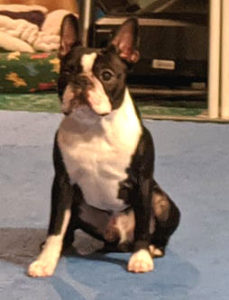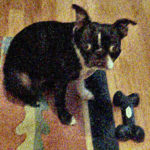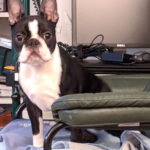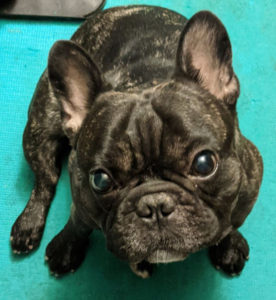
We would love to have a big training space. The recommended size of a competition obedience ring is 40 x 50 feet. 2000 square feet. Wouldn’t that be great? It’s also bigger than our entire house. Or yard. Much bigger.
Reality is that we generally have, at most, about a 6 x 10 foot space. Because real people have lives and furniture, and not big, open spaces to play with our dogs. The six by ten foot area stays clear because it’s also the entirety of our “home gym” – also known as the space we found to put down some kids’ snap-together play mats.
It’s not elaborate, it’s not solely dedicated to dog training, and we don’t have a lot of fancy equipment. If your space, time, and budget are limited (whose aren’t?), you substitute thought and creativity!
Play in a very small space!
All of the games in the 2-Minute-Trainer method can be played in a very small space. For most of them, all you need is room for you and your dog! Maybe a mat or rug. A little bowl or jar of treats.
In our competition obedience classes, we call these “kitchen exercises.” Because they’re the kind of things you can do with your dog while you’re waiting for the microwave. It’s probably where you keep the dog treats. And if you’re in the kitchen, and if your life is anything like ours, you’re already tripping over at least one dog in the room.
Instead of staring at your food turning in circles – teach your dog to spin! Both ways! Put those couple of minutes to use giving your dog something to do and a smile for yourself. It won’t take very long, if your dog is already on board with training games. And you’ll feel like you’ve accomplished something.
Playing training games with your dog is always entertaining. But it’s also building your relationship and your dog’s understanding. As much as he loves you now, that devotion will only grow when he sees you as a partner in the fun stuff you can do together.
Dogs love having a job. And they love making you smile and laugh. They love when you tell them they’re good, and smart, and the best puppy on the planet. And you’ll find that those couple of minutes, waiting for the leftovers to reheat in the microwave, will become one of your favorite times of the day.
A favorite game: “Put your ‘toys’ away”
One of our favorite games with our dogs is “Put your toys away.” We don’t use anything elaborate – the “toy bin” is a kitchen wash tub. The “toys” range from actual dog toys to old plastic kitchen utensils; mixing spoons, spatulas, even a pasta fork. The dogs don’t know that they’re not “toys” and they don’t judge the value of the space they’re playing in or equipment they’re using. They just know they’re getting attention, playing games with their favorite person, and having fun.




